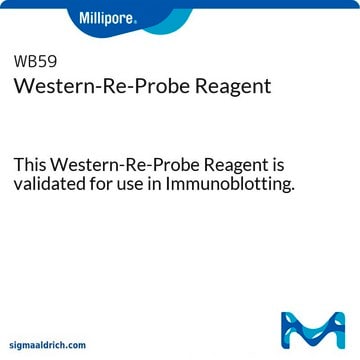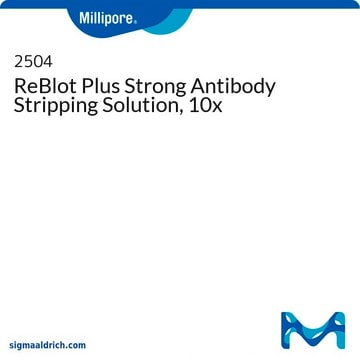2502
ReBlot Plus Mild Antibody Stripping Solution, 10x
Synonym(e):
Western blot stripping solution, blot stripping solution
About This Item
Empfohlene Produkte
Form
liquid
Verpackung
pkg of 50 mL
Hersteller/Markenname
Chemicon®
Re-Blot™
Methode(n)
western blot: suitable
Nachweisverfahren
chemiluminescent
Versandbedingung
wet ice
Verwandte Kategorien
Allgemeine Beschreibung
Stripping and reprobing of Western blots offers several advantages:
1) Conservation of samples that are expensive or available only in limited quantities,
2) Analysis of a given blot using several different antibodies, e.g. subtype- or isoform-specific antibodies,
3) Reanalysis of anomalous results and confirmation with the same or a different antibody,
4) Correcting errors in incubation with the wrong antibody,
5) Cost savings in reagents and time by reusing the same blot.
While antigen and antibody-based immunoaffinity matrices, such as Sepharose™ conjugates, have been reused many times without compromising antigen-antibody reactivity, the need for pH extremes and chaotropic agents has precluded the application of these methods to Western blotting.
The MILLIPORE Re-Blot Plus Western Blot Mild Antibody Stripping Solution contains specially formulated solutions that quickly and effectively remove antibodies from Western blots without significantly affecting the immobilized proteins.
Advantages of the Re-Blot Plus Western Blot Mild Antibody Stripping Solution include:
- No pungent smelling β-mercaptoethanol is contained in the Antibody Stripping Solution.
- Antibody stripping is done at room temperature. No heating of blots is required.
- Blots can be stripped of antibodies in approximately 15 minutes at room temperature.
- Blots may be reused in 25 minutes.
Anwendung
The Re-Blot Plus Western Blot Mild Antibody Stripping Solution should be used only for qualitative purposes until it has been established by comparative blot analysis that stripping does not quantitatively affect a given antigen.
This product is for research use only; not for diagnostic or in vivo use.
Komponenten
Lagerung und Haltbarkeit
Note: To prevent reagent degradation secure the cap tightly upon storage. Avoid extended exposure to air.
Rechtliche Hinweise
Haftungsausschluss
Signalwort
Danger
Gefahreneinstufungen
Acute Tox. 3 Dermal - Acute Tox. 4 Inhalation - Acute Tox. 4 Oral - Aquatic Chronic 2 - Eye Dam. 1 - Met. Corr. 1 - Skin Corr. 1A
Lagerklassenschlüssel
6.1B - Non-combustible acute toxic Cat. 1 and 2 / very toxic hazardous materials
WGK
WGK 2
Flammpunkt (°F)
Not applicable
Flammpunkt (°C)
Not applicable
Analysenzertifikate (COA)
Suchen Sie nach Analysenzertifikate (COA), indem Sie die Lot-/Chargennummer des Produkts eingeben. Lot- und Chargennummern sind auf dem Produktetikett hinter den Wörtern ‘Lot’ oder ‘Batch’ (Lot oder Charge) zu finden.
Besitzen Sie dieses Produkt bereits?
In der Dokumentenbibliothek finden Sie die Dokumentation zu den Produkten, die Sie kürzlich erworben haben.
Kunden haben sich ebenfalls angesehen
Unser Team von Wissenschaftlern verfügt über Erfahrung in allen Forschungsbereichen einschließlich Life Science, Materialwissenschaften, chemischer Synthese, Chromatographie, Analytik und vielen mehr..
Setzen Sie sich mit dem technischen Dienst in Verbindung.













